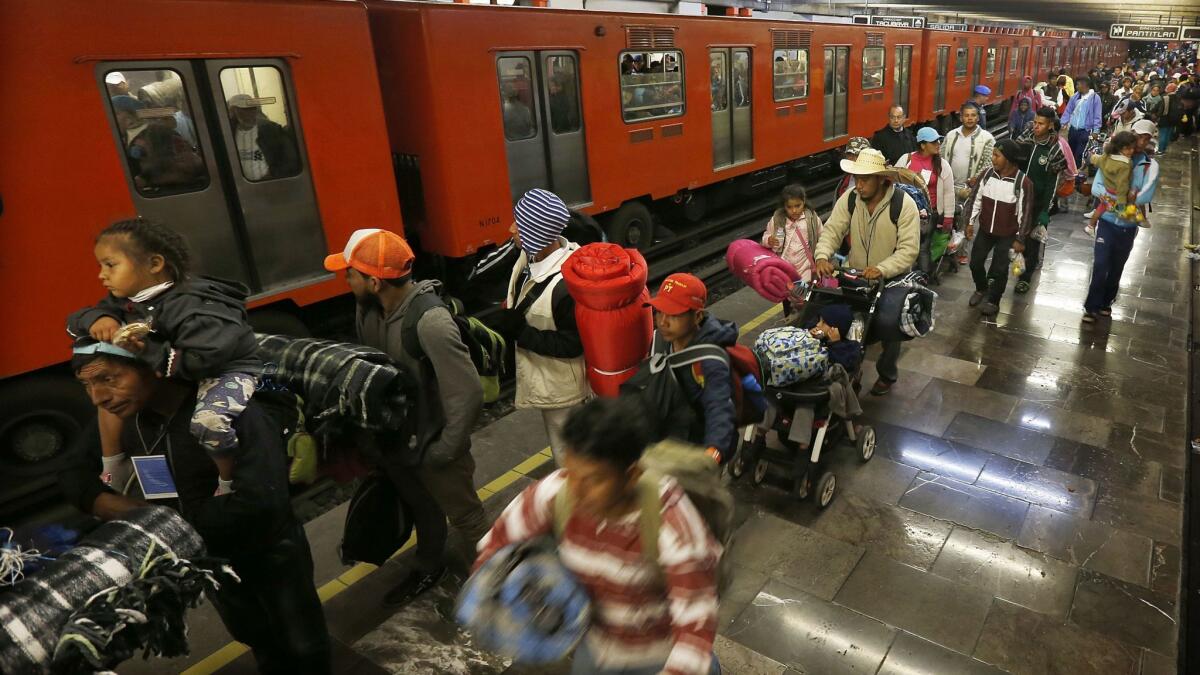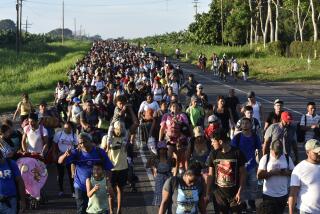Caravan migrants leave Mexico City en masse, headed for U.S.-Mexico border

Reporting from Mexico City — Thousands of Central Americans left Mexico City on Saturday bound for the U.S.-Mexico border, marking the latest stage in the journey of the migrant caravan that President Trump has labeled an invasion.
Having already traversed a broad swath of Central America and southern Mexico, the migrants embarked on a long trip to what many said was their destination — the Mexican border city of Tijuana, across from San Diego, some 1,700 miles to the northwest.
“We are going to Tijuana and from there to the United States,” said Alex Renderos, 22, a Guatemalan who was among the multitudes seeking to catch a train on Mexico City’s metro system out of this mega-city. “We want to work and send money to our families. I have four younger sisters and my parents back home.”
The exodus on Saturday appeared to include most of the estimated 5,500 Central Americans, mostly Hondurans, who had arrived in Mexico City in recent days. A smaller group of some 500 or so left the capital on Friday.
The exit from Mexico City — home to more than 20 million people — proved more complex and protracted than earlier departures from smaller towns and cities along the caravan route.
The migrants, lugging backpacks, bedrolls and shopping bags, and in some cases pushing baby carriages and toting stuffed animals, began streaming out in the predawn darkness from a sports field that had been transformed into a makeshift refugee camp since the weary travelers began arriving a week ago — after advancing through much of southern Mexico on foot and in cars, trucks and buses.
They filed into an elevated subway station adjacent to the athletic facility and boarded trains to a final stop in the sprawling capital’s northwestern periphery.
“How many lines are on the metro?” asked Renderos, perplexed as he tried to identify the correct train to take. “This is my first time ever on a metro.”
All were headed to the caravan’s next planned way station, the city of Queretaro, about 135 miles northwest.
After alighting from the subway, the migrants hiked along a traffic-clogged street beneath the major highway leading out of Mexico City. The roar of exhaust-belching vehicles provided a soundtrack for their determined march.
Those on the move were predominantly young men, but women and children form a significant part of the caravan population. Parents grasped their children’s hands as entire families advanced along the roadway.
Many gathered at bus stops, hoping for rides from passing vehicles. Police tried to maintain some semblance of order in the hazardous zones where dozens of migrants waited, often charging at moving trucks, buses and other conveyances that offered the possibility of a lift.
By midafternoon all caravan members appeared to have boarded trucks and other vehicles bound for Queretaro. Police and human rights officials and volunteers helped most to get rides from a toll plaza stop about 20 miles north of Mexico City.
“It’s hard, but we must move forward,” said Jenifer Castro, 24, a Honduran who held her 6-month-old daughter, Jenifer Alexandra, in a sling as two other children, ages 5 and 3, played on the curb. “We’ve come this far. We can’t go back.”
A bus stop shelter a few feet away featured an incongruous image of a smiling, ruddy Santa Claus hoisting a bottle of Coca-Cola.
Some people cheered and gave thumbs-up signs as vehicles packed with migrants passed by on a highway flanked by truck depots, shopping centers, fast-food joints and other commercial outlets.
Many migrants congregated at a toll booth some 15 miles north of the last subway stop, seeking rides.
Aid stations along the way provided food, medicine and other essentials.
Some eschewed the highway and took the subway to bus stations, where transportation to Queretaro cost about $10.
Their route could take them to a number of crossing areas along the U.S.-Mexico border, but many seemed determined to head to Tijuana.
Organizers had advised them that the trek to Tijuana and Mexico’s border with California was considerably safer than the much shorter route to the Texas border, via the state of Tamaulipas.
Tamaulipas is known as a danger zone where gangs prey on northbound migrants, subjecting them to extortion and other abuse.
The migrants seem destined to face a harsh welcome once they reach the U.S.-Mexico border.
President Trump, who repeatedly labeled the caravan a national security threat during campaign appearances in advance of the U.S. midterm election, has called up thousands of troops to the southwestern border and vowed that the migrants will be stopped. The Trump administration has also tightened the rules for political asylum in an apparent effort to make it harder for caravan members and other Central American migrants to gain a foothold in U.S territory.
Most of the migrants are nonetheless expected to seek political asylum in the United States, asserting that violence and threats in their homelands make it impossible for them to return without putting their lives in danger. The Trump administration’s public warnings have not deterred them.
Upon leaving the athletic facility in Mexico City, some migrants hoisted a handcrafted banner that read: “If Trump receives us, it will be a blessing for him. If he rejects us, it will be a curse” for the Honduran people.
Many of the migrants seemed refreshed after their stay in Mexico City, where authorities provided food, water and shelter. Some complained that they had caught colds in the high-altitude capital, where the winter evening chill was a stark contrast to the intense heat and humidity of southern Mexico and Central America.
Though most if not all of the migrants are in Mexico illegally, Mexican authorities have made little effort to halt their advance. Some 3,000 former caravan participants have opted to seek refugee status in Mexico, officials say, but others have joined up with the group as the journey progressed and replenished its ranks.
The migrant caravan set out almost a month ago, on Oct. 13, from the city of San Pedro Sula in Honduras. The group picked up members as the migrants made their way through Honduras and Guatemala before crossing the border into Mexico last month.
Meanwhile, two other U.S.-bound caravans of Central Americans — numbering more than 3,000, according to media accounts — are headed toward the Mexican capital from the south. Those caravans are expected to follow the same route as the initial group that left Mexico City on Saturday.
McDonnell is a staff writer and Sanchez is a special correspondent. Special correspondent Liliana Nieto del Rio contributed to this report.
Twitter: @PmcdonnellLAT
UPDATES:
5:10 p.m.: This article was updated with details that by midafternoon all caravan members appeared to have boarded trucks and other vehicles bound for the city of Queretaro.
This article was originally published at 12:50 p.m.
More to Read
Sign up for Essential California
The most important California stories and recommendations in your inbox every morning.
You may occasionally receive promotional content from the Los Angeles Times.










